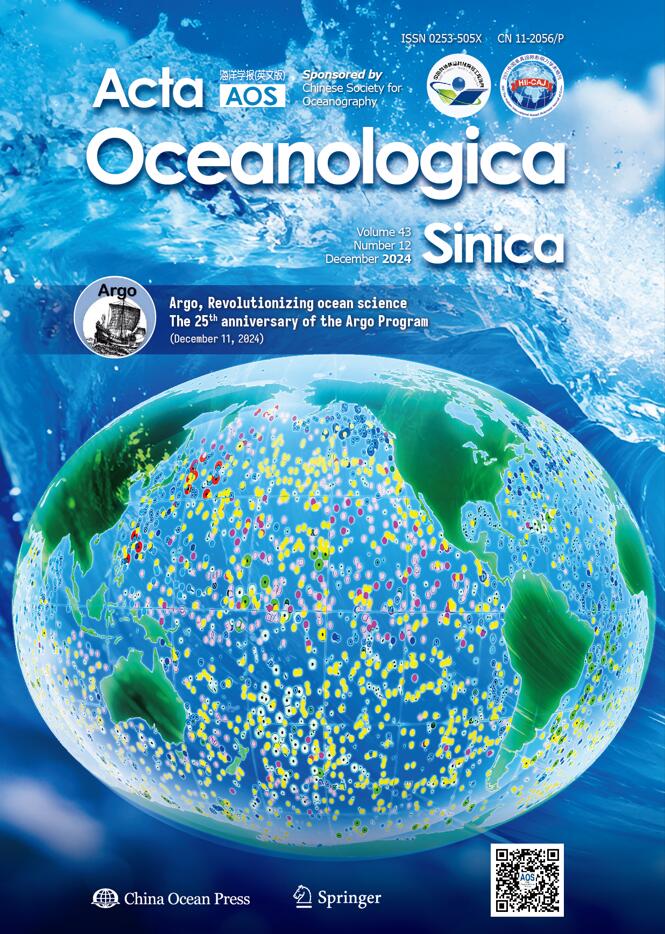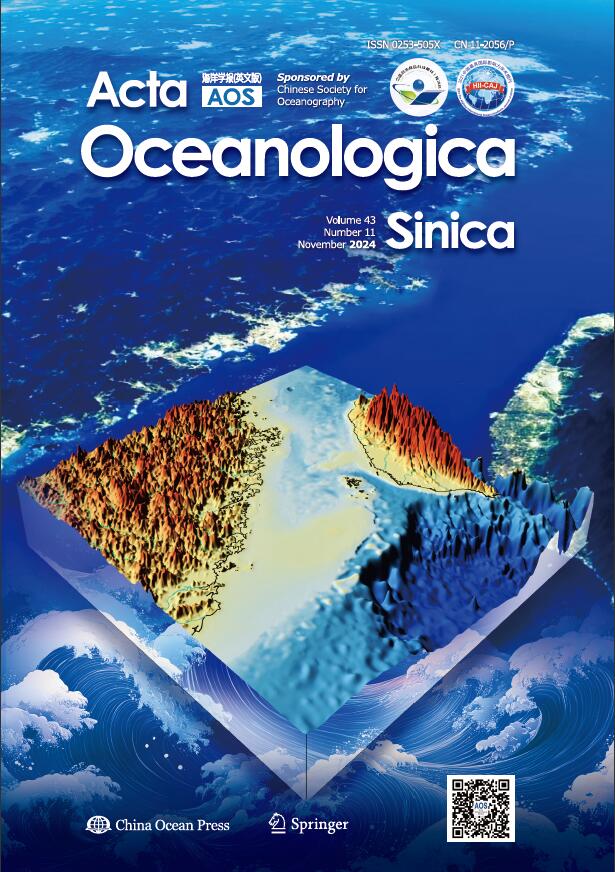2021 Vol. 40, No. 8
Display Method:
2021, (8): 1-2.
Abstract:
2021, 40(8): 1-13.
doi: 10.1007/s13131-021-1804-4
Abstract:
Selenium (Se) has been recognized as a key trace element that is associated with growth of primary producers in oceans. During March and May 2018, surface water (67 samples) was collected and measured by HG-ICP-MS to investigate the distribution and ...
Selenium (Se) has been recognized as a key trace element that is associated with growth of primary producers in oceans. During March and May 2018, surface water (67 samples) was collected and measured by HG-ICP-MS to investigate the distribution and ...
2021, 40(8): 14-31.
doi: 10.1007/s13131-021-1794-2
Abstract:
Based on a hydrodynamic-ecological model, the temperature, salinity, current, phytoplankton (Chl a), zooplankton, and nutrient (dissolved inorganic nitrogen, DIN, and dissolved inorganic phosphorous, DIP) distributions in the Beibu Gulf were simulate...
Based on a hydrodynamic-ecological model, the temperature, salinity, current, phytoplankton (Chl a), zooplankton, and nutrient (dissolved inorganic nitrogen, DIN, and dissolved inorganic phosphorous, DIP) distributions in the Beibu Gulf were simulate...
2021, 40(8): 32-43.
doi: 10.1007/s13131-021-1797-z
Abstract:
Saltmarshes are one of the most productive ecosystems, which contribute significantly to coastal nutrient and carbon budgets. However, limited information is available on soil nutrient and carbon losses via porewater exchange in saltmarshes. Here, po...
Saltmarshes are one of the most productive ecosystems, which contribute significantly to coastal nutrient and carbon budgets. However, limited information is available on soil nutrient and carbon losses via porewater exchange in saltmarshes. Here, po...
2021, 40(8): 44-52.
doi: 10.1007/s13131-021-1802-6
Abstract:
In terms of downward transport, suspended particulate matter (SPM) from marine or terrigenous sources is an essential contributor to the carbon cycle. Within mesoscale environments such as seagrass ecosystems, SPM flux is an essential part of the tot...
In terms of downward transport, suspended particulate matter (SPM) from marine or terrigenous sources is an essential contributor to the carbon cycle. Within mesoscale environments such as seagrass ecosystems, SPM flux is an essential part of the tot...
2021, 40(8): 53-64.
doi: 10.1007/s13131-021-1798-y
Abstract:
Hydrothermal venting has a profound effect on the chemical and biological properties of local and distal seawater and sediments. In this study, lipid biomarkers were analyzed to examine the potential influence of hydrothermal activity on the fate of ...
Hydrothermal venting has a profound effect on the chemical and biological properties of local and distal seawater and sediments. In this study, lipid biomarkers were analyzed to examine the potential influence of hydrothermal activity on the fate of ...
2021, 40(8): 65-77.
doi: 10.1007/s13131-021-1864-5
Abstract:
Mangroves can not only provide multiple ecosystem service functions, but are also efficient carbon producers, capturers, and sinks. The estimation of the organic carbon accumulation rate (OCAR) in mangrove sediments is fundamental for elucidating the...
Mangroves can not only provide multiple ecosystem service functions, but are also efficient carbon producers, capturers, and sinks. The estimation of the organic carbon accumulation rate (OCAR) in mangrove sediments is fundamental for elucidating the...
The influence of coupling mode of methane leakage and debris input on anaerobic oxidation of methane
2021, 40(8): 78-88.
doi: 10.1007/s13131-021-1803-5
Abstract:
Anaerobic oxidation of methane (AOM) is an important biogeochemical process, which has important scientific significance for global climate change and atmospheric evolution. This research examined the δ34S, terrigenous clastic indices of TiO2 and Al2...
Anaerobic oxidation of methane (AOM) is an important biogeochemical process, which has important scientific significance for global climate change and atmospheric evolution. This research examined the δ34S, terrigenous clastic indices of TiO2 and Al2...
2021, 40(8): 89-97.
doi: 10.1007/s13131-021-1791-5
Abstract:
The population parameters of blood cockles, Tegillarca granosa in the intertidal zone of Marudu Bay, Sabah, Malaysia were investigated based on monthly length-weight frequency data (July 2017 to June 2018). A total of 279 cockle individuals with shel...
The population parameters of blood cockles, Tegillarca granosa in the intertidal zone of Marudu Bay, Sabah, Malaysia were investigated based on monthly length-weight frequency data (July 2017 to June 2018). A total of 279 cockle individuals with shel...
2021, 40(8): 98-107.
doi: 10.1007/s13131-021-1796-0
Abstract:
Feeding activities provide necessary nutrition and energy to support the reproduction and development of fish populations. The feeding ecology and dietary plasticity of fish are important factors determining their recruitment and population dynamics....
Feeding activities provide necessary nutrition and energy to support the reproduction and development of fish populations. The feeding ecology and dietary plasticity of fish are important factors determining their recruitment and population dynamics....
2021, 40(8): 108-118.
doi: 10.1007/s13131-021-1793-3
Abstract:
Projection models are commonly used to evaluate the impacts of fishing. However, previously developed projection tools were not suitable for China’s fisheries as they are either overly complex and data-demanding or too simple to reflect the realistic...
Projection models are commonly used to evaluate the impacts of fishing. However, previously developed projection tools were not suitable for China’s fisheries as they are either overly complex and data-demanding or too simple to reflect the realistic...
2021, 40(8): 119-132.
doi: 10.1007/s13131-021-1789-z
Abstract:
Spatial-temporal distribution of marine fishes is strongly influenced by environmental factors. To obtain a more continuous distribution of these variables usually measured by stationary sampling designs, spatial interpolation methods (SIMs) is usual...
Spatial-temporal distribution of marine fishes is strongly influenced by environmental factors. To obtain a more continuous distribution of these variables usually measured by stationary sampling designs, spatial interpolation methods (SIMs) is usual...
2021, 40(8): 133-144.
doi: 10.1007/s13131-021-1790-6
Abstract:
In recent years, Konosirus punctatus has accounted for a large portion in catch composition and become important economic species in the South Yellow Sea. However, the distribution of K. punctatus early life stages is still poorly understood. In this...
In recent years, Konosirus punctatus has accounted for a large portion in catch composition and become important economic species in the South Yellow Sea. However, the distribution of K. punctatus early life stages is still poorly understood. In this...
2021, 40(8): 145-159.
doi: 10.1007/s13131-021-1801-7
Abstract:
Based on the Ricker-type models, the spawning stock-recruitment (S-R) relationship of Portunus trituberculatus was analysed under the impacts of environmental factors (including red tide area (AORT), sea level height (SLH), sea surface salinity (SSS)...
Based on the Ricker-type models, the spawning stock-recruitment (S-R) relationship of Portunus trituberculatus was analysed under the impacts of environmental factors (including red tide area (AORT), sea level height (SLH), sea surface salinity (SSS)...
2021, 40(8): 160-167.
doi: 10.1007/s13131-021-1800-8
Abstract:
Dietary studies of polyps and ephyrae are important to understand the formation and magnitude of jellyfish blooms and provide important insights into the marine food web. However, the diet of polyps and ephyrae in situ is largely unknown. Here, prey ...
Dietary studies of polyps and ephyrae are important to understand the formation and magnitude of jellyfish blooms and provide important insights into the marine food web. However, the diet of polyps and ephyrae in situ is largely unknown. Here, prey ...
2021, 40(8): 168-175.
doi: 10.1007/s13131-021-1823-1
Abstract:
DNA polymerase δ (Polδ) plays a crucial and versatile role in DNA replication and DNA repair processes. Vent shrimp Rimicaris exoculata is the primary megafaunal community living in hydrothermal vents. In this study, the Polδ from shrimp Rimicaris ex...
DNA polymerase δ (Polδ) plays a crucial and versatile role in DNA replication and DNA repair processes. Vent shrimp Rimicaris exoculata is the primary megafaunal community living in hydrothermal vents. In this study, the Polδ from shrimp Rimicaris ex...
2021, 40(8): 182-186.
doi: 10.1007/s13131-021-1792-4
Abstract:
In order to assess the effect of enhancement release of chum salmon (Oncorhynchus keta), otolith strontium (Sr) marking method was used to tag chum salmon released in Tangwang River in 2016. The homing chum salmon were detected and the samples were c...
In order to assess the effect of enhancement release of chum salmon (Oncorhynchus keta), otolith strontium (Sr) marking method was used to tag chum salmon released in Tangwang River in 2016. The homing chum salmon were detected and the samples were c...
2021, 40(8): 176-181.
doi: 10.1007/s13131-021-1884-1
Abstract:
This paper applies the narrow band Internet of things communication technology to develop a wireless network equipment and communication system, which can quickly set up a network with a radius of 100 km on water surface. A disposable micro buoy base...
This paper applies the narrow band Internet of things communication technology to develop a wireless network equipment and communication system, which can quickly set up a network with a radius of 100 km on water surface. A disposable micro buoy base...














